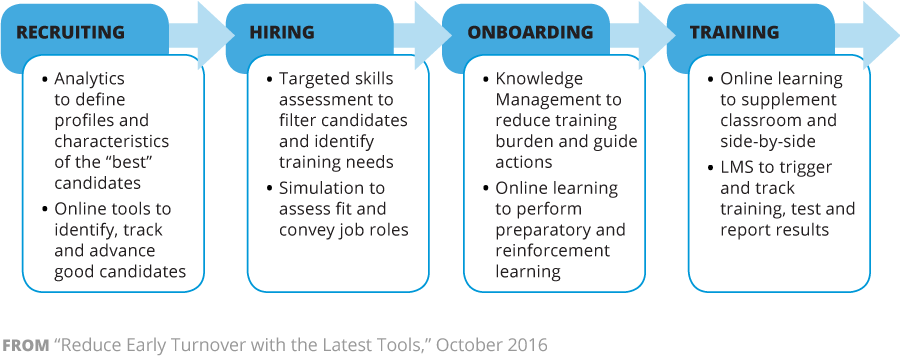
Many centers struggle to find the right frontline staff, and then suffer further when hirees don’t show up for training, quit during training, or quickly determine this job isn’t for them. The company invests significant time and money in the process with nothing but an FTE gap to show for it. Technology tools from vendors of enterprise applications, workforce optimization suites, and niche applications and services can address these all too common scenarios and launch centers on a fast track to better, more productive agents.
Recruiting. Some companies receive an abundance of resumes while others struggle to get candidates—or at least good ones. In either case, the goal is to attract and identify an appropriate number of qualified candidates. Technology can help by identifying top performers among existing employees and characterize their strengths through analytics tied to performance scorecards. This input enables centers to emphasize these qualities in job listings, screening techniques, and other recruitment efforts to find similar candidates. Insights on what works may also influence the places the jobs are posted and how the center uses staff to provide referrals or help promote the openings.
Hiring. Assessments, simulations, and other evaluation tools help ensure the candidate fits the center, and the job fits the candidate. Basic filtering tasks identify the best candidates to proceed to the next steps in the process. Examples for contact centers include: keyboard skills, listening skills, problem-solving skills, language skills, technical or application skills, personality characteristics suited to customer service or sales, and written skills if targeted for email, chat or other text-based interactions. Simulation can help the hirees gain insights to the job role and hirer understand how they’ll do in that role. Assessments can use predictive analytics to review the candidates’ results and compare to past hires and their performance on the job and predict success (or failure). They can also identify training needs.
Onboarding. Delaying a start date to align with a new hire class can risk losing someone to another job opportunity. When bringing people on before a training class starts, assign them some online learning modules that prepare them for the classroom or other formal training, and give them the basics on the processes, tools, soft skills, products, etc. Assign easy tasks that require minimal training and quick review but get them doing “hands-on” work, such as direct support to frontline agents. Use Knowledge Management and workflows to reduce the training burden and guide their actions. With good search functions, the new hire is led to bite-size knowledge that won’t overwhelm. Agents can shadow other staff, but can also benefit from sitting with Quality Assurance to gain exposure to the “best” contacts as well as some of the issues and things to avoid.
Training. This process can take many forms, with online, classroom, side-by-side and On-the-Job Training (OJT) being common. Effective training tools can help a center address diverse learning styles and create and deliver training in line with adult learning principles and change management concepts. Training should provide context of why the lessons are important, instill knowledge, let them do (practice, apply), and reinforce what was taught. Use technology to develop, deliver, trigger, test and track training. Contact center-specific tools can have the advantage of being integrated with Workforce Optimization (WFO) tools. For example, quality scores and coaching sessions identify training module needs, and the eLearning tool delivers training at the appropriate time as determined using the Workforce Management (WFM) system
Success starts with a strategy and plan that considers what you have and what you need to optimize recruiting, hiring, onboarding and training. Fine tune or reconfigure existing applications. Identify gaps and fill them with additional tools over time. Work with HR to leverage enterprise systems and use contact center-specific applications where appropriate. Invest in tools and define the processes to effectively leverage them, with skilled and trained people to manage and apply them. Then you will put your staff on a path to success Day One and eliminate those FTE gaps.




